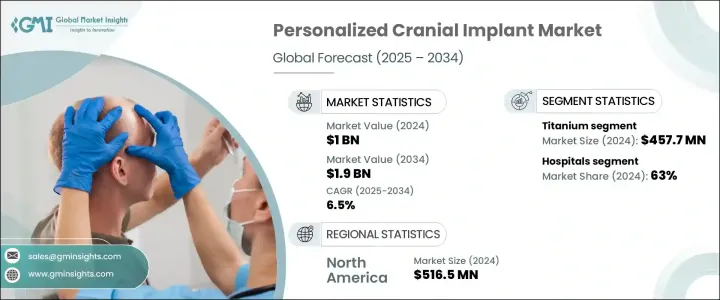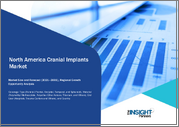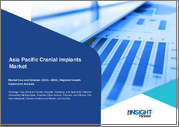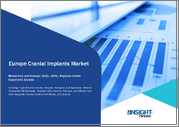
|
시장보고서
상품코드
1766268
세계의 맞춤형 두개골 임플란트 시장 : 기회, 성장 촉진요인, 산업 동향 분석, 예측(2025-2034년)Personalized Cranial Implant Market Opportunity, Growth Drivers, Industry Trend Analysis, and Forecast 2025 - 2034 |
||||||
세계의 맞춤형 두개골 임플란트 시장은 2024년 10억 달러로 평가되었으며 CAGR 6.5%로 성장해 2034년까지 19억 달러에 이를 것으로 추정됩니다.
외상성 뇌손상(TBI), 두개 결손의 유병률 증가, 임플란트 기술의 진보가 시장 확대의 주요 요인입니다. 최근 3D 프린팅은 쉽게 제조할 수 있는 정밀한 환자 고유의 임플란트를 가능하게 하고, 시장에 혁명을 가져왔습니다.

이러한 임플란트는 특히 외상이나 수술 후 두개골의 구조적 무결성을 회복하고 뇌가 적절하게 보호되도록 하는데 필수적입니다. 뇌척수액의 정상적인 흐름이 방해되어 뇌의 붓기나 탈장과 같은 위험한 상태가 될 수 있습니다.
| 시장 범위 | |
|---|---|
| 시작 연도 | 2024년 |
| 예측 연도 | 2025-2034년 |
| 시작 금액 | 10억 달러 |
| 예측 금액 | 19억 달러 |
| CAGR | 6.5% |
맞춤형 두개골 임플란트 시장의 티타늄 부문은 2024년 4억 5,770만 달러를 창출했습니다. 3D 프린팅을 사용해 다공질 구조로 변경할 수 있어 천연의 뼈 구조를 모방해, 환자의 뼈와의 일체화를 높일 수 있습니다.
2024년에는 두개골 수술을 필요로 하는 환자에게 종합적인 케어를 제공할 수 있는 병원이 시장의 최대 점유율을 차지하고 있습니다. 일반적으로 병원은 주문제작 임플란트를 채택하는 중요한 존재가 되고 있습니다. 다양한 증상에 대한 두개 임플란트의 사용을 모색하는 조사 프로젝트가 증가하고 있는 것이, 이 부문의 성장을 더욱 촉진할 것으로 예상되고 있습니다.
미국 맞춤형 두개골 임플란트 2024년 시장 규모는 4억 8,150만 달러로, 고령화, 교통사고 발생률 증가, 이용 가능한 치료 옵션의 인지도 증가가 배경에 있습니다. 주요 정형외과 장비 제조업체의 존재는 두개골 임플란트 기술의 혁신을 촉진하고 있습니다.
세계 맞춤형 두개골 임플란트 업계의 주요 기업으로는 Anatomics, Calavera, CranioTech, DePuy Synthes(JnJ), DOUBLE MEDICAL, INCREDIBLE, KELYNIAM, KLS Martin GROUP, LUCID, Matrix Surgical USA, ORTHO BALTIC implants, Stryker, XILLOC 등이 있습니다. 시장 포지션을 강화하기 위해 맞춤형 두개골 임플란트 분야의 기업들은 지속적인 기술 발전에 주력하고 있습니다. 3D 프린팅이나 적층 조형에 다액의 투자를 실시해, 고정밀도의 환자 전용 임플란트를 제조하고 있습니다. 또한 기업들은 병원과 연구기관과 전략적 파트너십과 협력 관계를 맺고 기술 혁신의 최전선에 서서 있습니다. 생체 친화성을 높이고 뼈와의 통합을 위해 티타늄을 사용하는 등 임플란트의 재료 특성을 개선함으로써, 이들 기업은 자사 제품이 환자와 의료 제공업체의 진화하는 요구에 확실히 대응하고 있습니다.
목차
제1장 조사 방법과 범위
제2장 주요 요약
제3장 업계 인사이트
- 생태계 분석
- 공급자의 상황
- 각 단계에서의 부가가치
- 밸류체인에 영향을 주는 요인
- 업계에 미치는 영향요인
- 성장 촉진요인
- 외상성 뇌 손상 및 두개 결손의 발생률의 상승
- 미용과 기능 회복에 대한 수요 증가
- 외상 증례 증가
- 재료 기술의 진보
- 업계의 잠재적 위험 및 과제
- 임플란트 비용이 높고 접근이 제한
- 커스텀 임플란트의 규제상의 과제
- 기회
- 생체 흡수성 및 재생성 임플란트의 개발
- 미개발 시장 및 신흥 시장으로의 확대
- 성장 촉진요인
- 성장 가능성 분석
- 규제 상황
- 북미
- 유럽
- 세계 기타 지역
- 기술과 혁신의 상황
- 3D 프린팅과 CAD/CAM 기술
- 신흥기술
- 가격 동향
- 지역별
- 제품별
- 미래 시장 동향
- 상환 시나리오
- 상환 정책이 시장 성장에 미치는 영향
- 소비자 행동 분석
- 갭 분석
- Porter's Five Forces 분석
- PESTEL 분석
제4장 경쟁 구도
- 소개
- 기업의 시장 점유율 분석
- 세계
- 북미
- 유럽
- 세계 기타 지역
- 기업 매트릭스 분석
- 주요 시장 기업의 경쟁 분석
- 경쟁 포지셔닝 매트릭스
- 주요 발전
- 합병인수
- 파트너십 및 협업
- 신제품 발매
- 확장 계획
제5장 시장 추계 및 예측 : 임플란트 재료별, 2021-2034년
- 주요 동향
- 티타늄
- PMMA(폴리메틸메타크릴레이트)
- PEEK(폴리에테르에테르케톤)
- 기타 임플란트 재료
제6장 시장 추계 및 예측 : 최종 용도별, 2021-2034년
- 주요 동향
- 병원
- 외래수술센터(ASC)
- 기타 최종 용도
제7장 시장 추계 및 예측 : 지역별, 2021-2034년
- 주요 동향
- 북미
- 미국
- 캐나다
- 유럽
- 독일
- 영국
- 프랑스
- 스페인
- 이탈리아
- 아시아태평양
- 중국
- 일본
- 인도
- 호주
- 한국
- 라틴아메리카
- 브라질
- 멕시코
- 아르헨티나
- 중동 및 아프리카
- 남아프리카
- 사우디아라비아
- 아랍에미리트(UAE)
제8장 기업 프로파일
- Anatomics
- Calavera
- CranioTech
- DePuy Synthes(JnJ)
- DOUBLE MEDICAL
- INCREDIBLE
- KELYNIAM
- KLS martin GROUP
- LUCID
- Matrix Surgical USA
- ORTHO BALTIC implants
- Stryker
- XILLOC
The Global Personalized Cranial Implant Market was valued at USD 1 billion in 2024 and is estimated to grow at a CAGR of 6.5% to reach USD 1.9 billion by 2034. The growing prevalence of traumatic brain injuries (TBI), cranial defects, and advancements in implant technologies are major drivers of market expansion. As the number of TBI cases rises, especially due to accidents and medical conditions, the demand for customized cranial implants has also increased. These implants are tailored to fit a patient's unique anatomical structure using advanced imaging techniques such as CT and MRI scans. Recently, 3D printing has revolutionized the market by enabling precise, patient-specific implants that can be easily manufactured. Conditions like craniosynostosis, where a child's skull prematurely fuses, further contribute to the demand for personalized implants.

These implants are vital in restoring the skull's structural integrity, particularly after trauma or surgical procedures, ensuring that the brain is adequately protected. By providing a custom fit, personalized cranial implants prevent complications such as increased intracranial pressure, which can lead to further neurological damage or impair brain function. When the skull is compromised, it can interfere with the normal flow of cerebrospinal fluid, resulting in dangerous conditions like brain swelling or herniation. By addressing these issues, cranial implants not only improve the patient's quality of life but also reduce the risk of severe long-term complications. As a result, the demand for these personalized implants is surging, contributing to the market's robust growth.
| Market Scope | |
|---|---|
| Start Year | 2024 |
| Forecast Year | 2025-2034 |
| Start Value | $1 Billion |
| Forecast Value | $1.9 Billion |
| CAGR | 6.5% |
The titanium segment in the personalized cranial implant market generated USD 457.7 million in 2024. Titanium is highly favored due to its strength, lightweight, and compatibility with human tissue. Additionally, it can be modified into porous structures using 3D printing, mimicking natural bone structure, and enhancing integration with the patient's bone. This unique feature is essential for promoting bone growth around the implant and ensuring long-term stability. Titanium's versatility in manufacturing, especially in additive manufacturing, allows for precise customization, making it a top choice for personalized cranial implants. This trend is expected to continue as the demand for tailored medical solutions increases.
In 2024, hospitals accounted for the largest share of the market, driven by their ability to provide comprehensive care for patients requiring cranial surgeries. Hospitals are equipped with advanced medical technologies and specialized surgeons who perform detailed evaluations, surgeries, and post-operative rehabilitation for cranial procedures. As patient-specific treatments become more common, hospitals have become key adopters of customized implants. The increasing number of research projects exploring the use of cranial implants for various conditions is further anticipated to fuel growth in this segment.
United States Personalized Cranial Implant Market was valued at USD 481.5 million in 2024, driven by the aging population, higher incidence of road accidents, and growing awareness of available treatment options. The country's established healthcare infrastructure and the presence of leading orthopedic device manufacturers foster innovation in cranial implant technologies. Furthermore, the U.S. market benefits from increasing healthcare spending, advanced medical facilities, and a high number of qualified medical professionals, all of which contribute to market growth.
Leading companies in the Global Personalized Cranial Implant Industry include Anatomics, Calavera, CranioTech, DePuy Synthes (JnJ), DOUBLE MEDICAL, INCREDIBLE, KELYNIAM, KLS Martin GROUP, LUCID, Matrix Surgical USA, ORTHO BALTIC implants, Stryker, and XILLOC. To strengthen their market position, companies in the personalized cranial implant sector focus on continuous technological advancements. They are investing heavily in 3D printing and additive manufacturing to create highly accurate, patient-specific implants. Additionally, firms are forming strategic partnerships and collaborations with hospitals and research institutions to stay at the forefront of innovation. By improving the material properties of implants, such as using titanium for enhanced biocompatibility and integration with bone, these companies ensure that their products meet the evolving needs of patients and healthcare providers.
Table of Contents
Chapter 1 Methodology & Scope
- 1.1 Market scope & definitions
- 1.2 Research design
- 1.2.1 Research approach
- 1.2.2 Data collection methods
- 1.3 Data mining sources
- 1.3.1 Global
- 1.3.2 Regional/Country
- 1.4 Base estimates & calculations
- 1.4.1 Base year calculation
- 1.4.2 Key trends for market estimation
- 1.5 Primary research and validation
- 1.5.1 Primary sources
- 1.6 Forecast model
- 1.7 Research assumptions and limitations
Chapter 2 Executive Summary
- 2.1 Industry 3600 synopsis
- 2.2 Key market trends
- 2.2.1 Regional
- 2.2.2 Implant material
- 2.2.3 End Use
- 2.3 CXO perspectives: Strategic imperatives
- 2.3.1 Key decision points for industry executives
- 2.3.2 Critical success factors for market players
- 2.4 Future outlook and strategic recommendations
Chapter 3 Industry Insights
- 3.1 Industry ecosystem analysis
- 3.1.1 Supplier landscape
- 3.1.2 Value addition at each stage
- 3.1.3 Factor affecting the value chain
- 3.2 Industry impact forces
- 3.2.1 Growth drivers
- 3.2.1.1 Rising incidence of traumatic brain injuries and cranial defects
- 3.2.1.2 Growing demand for aesthetic and functional recovery
- 3.2.1.3 Rise in number of trauma cases
- 3.2.1.4 Technological advancements in materials
- 3.2.2 Industry pitfalls & challenges
- 3.2.2.1 High implant cost and limited access
- 3.2.2.2 Regulatory challenges for custom implants
- 3.2.3 Opportunities
- 3.2.3.1 Development of bioresorbable and regenerative implants
- 3.2.3.2 Expansion in untapped and emerging markets
- 3.2.1 Growth drivers
- 3.3 Growth potential analysis
- 3.4 Regulatory landscape
- 3.4.1 North America
- 3.4.2 Europe
- 3.4.3 Rest of the world
- 3.5 Technology and innovation landscape
- 3.5.1 3D printing and CAD/CAM technologies
- 3.5.2 Emerging technologies
- 3.6 Price trends
- 3.6.1 By region
- 3.6.2 By product
- 3.7 Future market trends
- 3.8 Reimbursement scenario
- 3.8.1 Impact of reimbursement policies on market growth
- 3.9 Consumer behaviour analysis
- 3.10 Gap analysis
- 3.11 Porter's analysis
- 3.12 PESTEL analysis
Chapter 4 Competitive Landscape, 2024
- 4.1 Introduction
- 4.2 Company market share analysis
- 4.2.1 Global
- 4.2.2 North America
- 4.2.3 Europe
- 4.2.4 Rest of the world
- 4.3 Company matrix analysis
- 4.4 Competitive analysis of major market players
- 4.5 Competitive positioning matrix
- 4.6 Key developments
- 4.6.1 Mergers & acquisitions
- 4.6.2 Partnerships & collaborations
- 4.6.3 New product launches
- 4.6.4 Expansion plans
Chapter 5 Market Estimates and Forecast, By Implant Material, 2021 – 2034 ($ Mn)
- 5.1 Key trends
- 5.2 Titanium
- 5.3 PMMA (Polymethylmethacrylate)
- 5.4 PEEK (Polyether ether ketone)
- 5.5 Other implant materials
Chapter 6 Market Estimates and Forecast, By End Use, 2021 – 2034 ($ Mn)
- 6.1 Key trends
- 6.2 Hospitals
- 6.3 Ambulatory surgical centers
- 6.4 Other end use
Chapter 7 Market Estimates and Forecast, By Region, 2021 – 2034 ($ Mn)
- 7.1 Key trends
- 7.2 North America
- 7.2.1 U.S.
- 7.2.2 Canada
- 7.3 Europe
- 7.3.1 Germany
- 7.3.2 UK
- 7.3.3 France
- 7.3.4 Spain
- 7.3.5 Italy
- 7.4 Asia Pacific
- 7.4.1 China
- 7.4.2 Japan
- 7.4.3 India
- 7.4.4 Australia
- 7.4.5 South Korea
- 7.5 Latin America
- 7.5.1 Brazil
- 7.5.2 Mexico
- 7.5.3 Argentina
- 7.6 Middle East and Africa
- 7.6.1 South Africa
- 7.6.2 Saudi Arabia
- 7.6.3 UAE
Chapter 8 Company Profiles
- 8.1 Anatomics
- 8.2 Calavera
- 8.3 CranioTech
- 8.4 DePuy Synthes (JnJ)
- 8.5 DOUBLE MEDICAL
- 8.6 INCREDIBLE
- 8.7 KELYNIAM
- 8.8 KLS martin GROUP
- 8.9 LUCID
- 8.10 Matrix Surgical USA
- 8.11 ORTHO BALTIC implants
- 8.12 Stryker
- 8.13 XILLOC



















